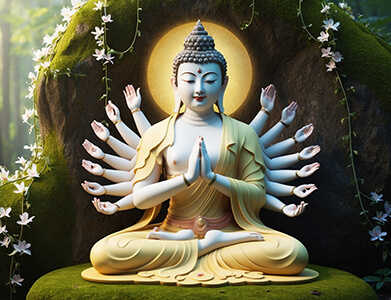
Om Mani Peme Hum Mantra
Avalokitesvara is a Buddhist deity who embodied the Bodhisattva ideal of compassion. He evolved in Tibet into the female buddha Kuan Yin. The main mantra associated with Avalokitesvara is the six-syllable mantra “Om Mani Padme Hum.” This mantra literally means, “Hail to the jewel in the lotus!”
Share this page with a friend!
Watch nearly 400 videos on the Vocal Medicine Channel!
Word for Word Translation
OM: OM is the sound of the universe, the sound from which all other sounds are formed. OM represents past, present and future. OM is a seed or building block of creation.
MANI: a jewel or precious gem, symbolic of the soul or the inner light
PEME: a variation of the word “padme” meaning the lotus, symbolizing spiritual enlightenment. Lotus flowers mean purity, rebirth and divinity.
HUM: a fire element seed syllable that can help to kindle the consciousness. This is an etheric fire connected to lightning, pranic fire, and the breath. This lightning can also be used for protection.
To learn more about Kuan Yin, visit Kuan Yin Healing Mantras.
Meaning of Avalokiteshvara’s Name
Avalokiteśhvara serves as a guiding figure for those seeking mercy, comfort, and spiritual salvation. The name “Avalokiteśhvara” or “Avalokitsvara” translates roughly to “The Lord Who Looks Down (with compassion),” indicating his boundless concern for the suffering of all beings.
Origins of Avalokiteshvara
The origins of Avalokiteśhvara can be traced to early Mahāyāna texts, with the Lotus Sutra and the Karandavyuha Sutra offering detailed descriptions of his qualities and miraculous interventions. Over centuries, the bodhisattva evolved into various forms across cultures.
Evolving Into Kuan Yin
In India, Avalokiteśhvara was often depicted as a male figure. However, in East Asia, especially in China, the deity gradually took on a more feminine appearance, evolving into Kuan Yin or Guan Yin, known as the Goddess of Mercy.
Symbols of Avalokitesvara
Symbolism is central to understanding Avalokiteśvara. He is frequently depicted with multiple arms and heads, symbolizing his ability to perceive the suffering of countless beings and act in all directions to alleviate it.
The Many Arms of Avalokitesvara
A common representation includes eleven heads and a thousand arms, each with an eye in the palm, embodying his omniscience and omnipotent compassion. In his hand, he often holds a lotus flower, a symbol of purity, or a vase pouring the nectar of wisdom and healing.
Author Kathleen Karlsen
Kathleen Karlsen is a musician, artist, writer and speaker. She is the author of two books (Flower Symbols and Vocal Medicine) and over 200 articles. Kathleen, her husband Andrew, and their five children live in Bozeman, Montana. More about Kathleen Karlsen.
Om Mani Peme Hum Article Summary
Avalokiteshvara is a Buddhist deity who embodied the Bodhisattva ideal of compassion. The main mantra associated with Avalokiteshvara is the six-syllable mantra “Om Mani Padme Hum.” This mantra literally means, “Hail to the jewel in the lotus!”
Click for all content on our Site Map
Watch nearly 400 videos on the Vocal Medicine Channel!
Share this page with a friend!
Listen on Spotify!
Click to hear
108x Around the Heart
Click to hear
Vocal Medicine Kirtan







